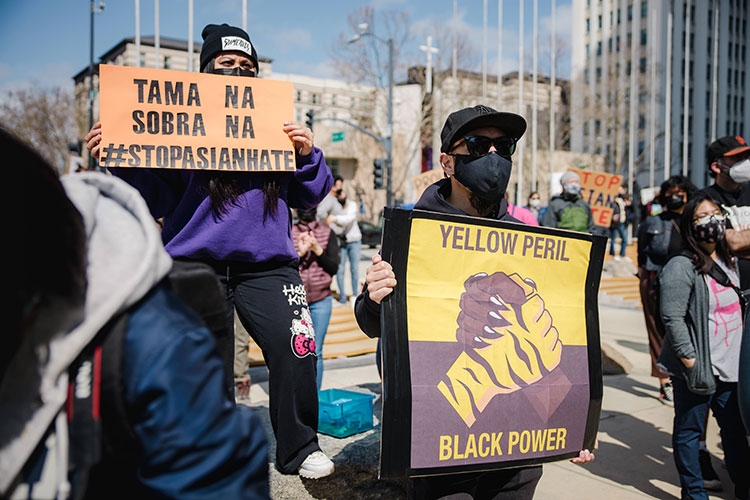To stop the rise in anti-Asian violence, and the continuing police violence against Black communities in America, Black and Asian communities must build coalitions to combat the white supremacist structures, and institutions, that founded America.
That’s according to a prominent panel of Black and Asian American scholars and activists from across the country who, on Thursday, joined UC Berkeley’s Othering and Belonging Institute, for the livestreamed event, “Rise Up for Justice: Beyond Solidarity — Bridging the Black-Asian Divide.”
“It is the structural and ideological architecture that kneels on the necks of Black people on a daily basis and demonizes Asians and Pacific Islanders and all people of color,” said Othering and Belonging analyst Gerald Lenoir , who moderated the discussion. “(People of color) have a common political framework against white supremacy and economic exploitation… We can come together without negating our original identities.”
Cat Brooks , executive director of the Anti Police-Terror Project , said she first began working with Asian American organizers in Oakland who supported the Black Lives Matter Movement in 2015 and “stood in solidarity with us.”

A ‘Stop Asian Hate’ protest in San Jose, California in March 2021 had a coalition of protestors from different ethnic backgrounds. (Photo by Jason Leung/Unsplash)
Brooks said both communities are intentionally exposed to propaganda from the mainstream media that perpetuates the stereotypes of each group — in order to divide them.
“What white supremacy has done, unfortunately, is make us think the only way we can achieve the ‘American dream,’ is if we take it from each other,” said Brooks. “As opposed to focusing on the people that are holding all the resources, that are blocking all the doors to access.”
Despite those structural barriers to unity, Tracy La, co-founder of VietRise , a social justice group that organizes working class Vietnamese and immigrant communities in Orange County, said there are real points of contention that need to be acknowledged.
La, who has built coalitions with Black organizers to combat ICE and police violence, said with the recent rise in anti-Asian violence during the pandemic, there have been calls for more police funding in certain parts of the Asian American community.
“There has to be accountability for the violence against Asian people and our Asian elders,” said La. “But what some of us think is going to keep us safe actually hurts our communities. Asian people need to hear other Asian people say that more police don’t keep us safe.”
Cal State Los Angeles professor Melina Abdullah co-founded L.A.’s Black Lives Matter group and was raised in East Oakland where “Black folks and Asian folks shared the same space.”
Abdullah, who is an expert on race, gender and social movements, said Asian and Black communities can build on a long history of solidarity that is often ignored by the greater public.

Yuri Kochiyama, a Japanese American civil rights activist and her friend, Malcolm X, are immortalized on a mural in Harlem, New York. (Photo courtesy of Flickr)
“But I don’t want to paint too rosy of a picture,” Abdullah said. “We’re still not healed from the murder of Latasha Harlins . We’re still not healed from many practices which I think really illuminate different class positioning, as well as different racial positioning.”
“But we’ve seen forms of organic solidarity where Asian folks have engaged in our struggle,” added Abdullah. “I’m really grateful for Asian folks who are not falling for the ‘okey doke’ from police unions … I think that the powers that be feel threatened by that.”
Those coalitions can grow stronger by reaching out to people who do not typically participate in social justice activism, to get more involved, said Ali Ture, a queer community organizer with Asian Americans Advancing Justice in Atlanta .
“The foundation of organizing, and how we’re going to change the world, is through building relationships and being intentional on how we build those relationships,” Ture said. “… To put ourselves in a proactive position where we can act, as opposed to react.”
Brooks added that both communities also should continue to have conversations around the challenges they face in working together.
“It can be hard, because there are folks on both sides that say ‘we have our own problems: Why do we have to go and do (something) for anybody else,'” said Brooks. “But it’s about standing in that gap, and connecting the dots to realize that if one of us isn’t free, none of us are free.”

